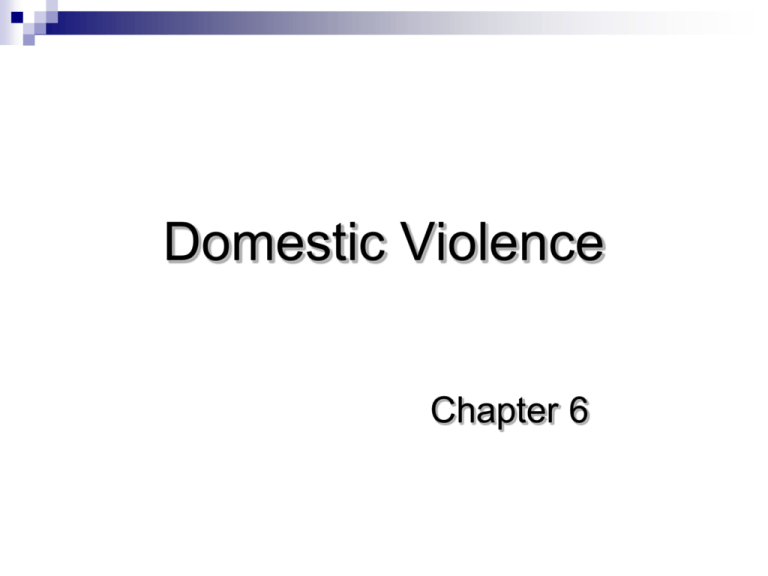
Domestic Violence
Chapter 6
Defining Domestic Violence
“Threatening behaviour, violence, or
abuse (psychological, physical, sexual,
financial or emotional) between adults who
are or have been intimate partners or are
family members, regardless of gender or
sexuality”
Domestic Violence
OLD
Umbrella term: Spousal violence; intimate partner
violence; domestic abuse; wife abuse; spouse
battering; family violence
Abuse can include:
Physical
Sexual
Emotional
Financial, economic
Family Violence
Nature of domestic violence
Adolescent-to-parent; parent to child
Sibling-to-sibling
Spouse-to-spouse
Prevalence
Depends on definition & measurement:
Conflict Tactics Scale (CTS)
Victimization survey findings
The Conflict Tactics Scale (CTS)
Most commonly used scale to measure domestic
violence (1979)
1st reliable & valid scale for measuring family
violence (verbal aggression & physical violence
on a continuum)
Females engage in minor physical violence
Males engage in more serious physical
violence
Criticisms - Incidence rates sometimes
generalized from small & unrepresentative samples
Extent of Family Violence
A pressing social issue
1993
telephone survey of 12,300 Canadian women
indicated 29% had been subjected to violence (Stats
Can 1988)
More than 14,000 women & children admitted to
women’s shelters in BC between April 1, 1999 and
March 31, 2000 (Stats Can, 2001)
(2002) est. 55,000 women & 45,000 children (under
10) admitted to shelters; 12% returned to spouse
Statistics Canada Violence
Against Women Survey (1999)
Used modified CTS to measure physical,
psychological, and sexual violence in
intimate relationships
Both men and women experience
violence
Women experience more severe forms
Violence against women more likely
reported to police
Types of Relationship Violence
Experienced (Statistics Canada, 2006a)
Domestic Violence
2006 police-reported data:
38,000 incidents/ 15% violent incidents
o 83% of victims female; 17% male
o Common assault most frequently reported
o Charges laid by police in ¾ of all policereported incidents
o
Criminal Justice Response
Reasons for not reporting??
Mandatory charging policies give police
authority to lay charges against an assault
suspect
What characterizes an Abuser?
Heterogeneous group
Generally violent men (assaultive both
inside & outside the home)
Widely accepted that power needs drives
much offending
Classifications from text
Subtypes
of batterers
Risk Factors & Domestic Violence
Psychological characteristics
More
angry (overcontrolled?)
Emotional dependence (Jekyll & Hyde type?)
Insecure
Low self-esteem
APD, narcissism
Anxiety, depression, mood disorders, PTSD
Theoretical Perspectives
One’s perspective influences answers
Issue:
perpetrator’s misuse of power, control
& authority
Complexity
of studying
Theoretical Perspectives
Biological theories:
Biological
influences may predispose
Genes may predispose but do not
determine behaviour
Neuropathology, head injury, hormones,
neurotransmitters
Theoretical Perspectives
Psychological theories:
Why
some do and others don’t
Factors in the individual that lead to an
inclination to commit a violent crime
Social learning, psychopathology, impulsecontrol problems, low self-esteem, attitudes,
personality, attachment…………………….
Zimbardo, Milgram studies
Theoretical Perspectives
Social learning theory
Aggression
Past learning experiences
Observing or experiencing aggression
Own aggression refined through reinforcement
Importance
of models
Family members, subculture, mass media
Cognitive
is acquired
factors especially important
Cognitive scripts
Attributions
Theoretical Perspectives
Feminist theory
Gendered
nature of both deviance & control
Patriarchal society (broad set of cultural beliefs and
values that support male dominance of woman)
Sociological theories: Systems theory
Family
interaction patterns
Interpersonal conflict violence (pushing, shoving)
Non-systematic abuse (kicking, hitting, throwing objects)
Systematic abuse (beating, choking, knives, guns)
Roles,
relationships, & feedback mechanisms
Social stress & disorganization (conflictual families)
Theoretical Explanations of
Family Violence
Theories underdeveloped
Reciprocal interactionism of family dynamics
critical
Cessation of family violence
Official
response & community support important
Male-dominating tradition often seen at root of family
violence
Efforts to change abuser’s attitudinal system
Etiology (causes)
Violence doesn’t necessarily beget
violence
Adult offenders often claim abuse as
children
No
strong documentation
Cuts across socioeconomic, religious,
racial, ethnic lines
Etiology continued
Alcohol and other drugs
alcohol & drug use exacerbator; not cause
Male’s perceived loss of power
Is family violence different from general
violence?
Need to understand interactional dynamics
Risk Factors and Domestic
Violence
Correlational only
Wife
working & husband not working
Violence in family of origin
Fear of abandonment
Youth
Lower SES
Unemployment
Prior arrest for violent crime
Substance abuse
Risk Assessment
Instruments
SARA
Designed
to assess risk of re-offending in CJS
Interventions
Projects, programs, policies & practices
Safe houses for victims
Police practices
CBT
Predictors of Partner Violence
Interactional; arise from relationship
processes such as:
Marital
conflict
Customary modes of expressing aggression
Stresses induced by work
Wife-to-Husband Violence
More common than you think
Different reasons for violence against spouses
Battered women who kill are more likely to
believe lives in danger
Psychological Effects of Domestic
Violence on Children
Risk factors must be considered
Age, nature of violence
Overall, more behavioural and emotional problems
(aggression)
Both externalized and internalized behaviours
Numerous research studies demonstrating negative
effects
Affect on children’s own cognitive structures & attitudes
is critical
Effects of Violence on Children
Feelings of fear, anger, depression, anxious, grief,
shame, despair & distrust, aggression
Sense of powerlessness
Physical reactions: stomach cramps, headaches,
sleeping/eating disorders; bed-wetting
Slowed developmental capacities (difficulties in school)
Substance abuse
Learning that violence is a legitimate means
for obtaining control of a situation or for
resolving conflict
Stalking and Domestic Violence
Stalking – new form of criminal deviance
Common;
associated with gendered abuse & violence
1996 – 80% of 4,450 victims women; 88% of stalkers
were men
“willful, repeated and malicious following, harassing or
threatening of another person”
Mostly, prior intimate relationships
Broad range of behaviours
Threats,
spying, following, vandalized property,
threatening to kill or killed pets
Stalking Behaviour
Stalking victimization is reported by 4% of
Canadian women and 2% of men
(Canadian Centre for Justice Statistics, 2005)
Targeted harassment is concerning:
Stalking
behaviour is a persistent and threatening
form of violence that can severely affect the mental
health of victims and those close to them
Estimated that 25 – 30% of stalking involves violence
Celebrities







